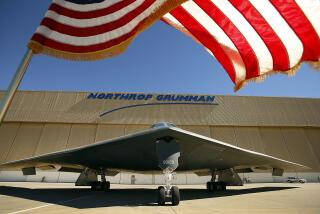Raytheon Job Cuts to Include O.C. Facility
- Share via
WASHINGTON — Raytheon Co. is expected to announce a consolidation plan as early as this week that will eliminate an estimated 5,000 to 10,000 jobs at its defense and aerospace operations nationwide, including at the former Hughes Aircraft facility in Fullerton, according to industry and company sources.
The company, which completed its acquisition of Hughes Aircraft in late December, is seeking to reduce costs by 10% to 15% at its Raytheon Systems unit, which includes the former aerospace operations of Hughes and Texas Instruments.
Raytheon, headquartered in Lexington, Mass., is also expected to announce a pretax charge of as much as $400 million to cover the costs of the restructuring when it releases its 1997 earnings next Monday, PaineWebber analyst Jack Modzelewski said.
It is unknown how many job cuts would fall in California, where Raytheon has 18,000 employees, 2,500 of them in Fullerton and the rest in El Segundo. The firm has 87,000 defense jobs nationwide, though it does not plan to cut 15% of those. Rather, it is hoping to wring efficiencies out of the merger that would offset even deeper employment cutbacks.
Raytheon spokesman Robert S. McWade confirmed that the company is close to making the restructuring announcement, but he declined to say how many jobs are at stake.
“We have had teams working for the better part of a year to put that plan in place,” McWade said. “There are two primary reasons we are doing it: to grow revenue and cut costs.”
Aerospace analysts said that even taking into consideration the firm’s optimism about cutting costs through improving business efficiency, about 5,000 to 10,000 jobs are at stake. A Raytheon manager told The Times that he has received word of a 10,000-job cutback. Attrition, rather than layoffs, could account for a significant portion of any reductions.
Despite the looming cutbacks, Raytheon is still hiring in some areas. It has 6,500 openings for engineers and technicians that it is finding difficult to fill. Indeed, its reorganization will probably be strongly affected by where it can find large pools of engineers, a strong point of Southern California.
“This is a pretty important reorganization,” Modzelewski said. “To save money, you have to cut people. And if you cut people, you open yourself up to all kinds of political considerations. You have California, Texas and Massachusetts--some pretty strong bastions of defense spending where everybody wants to defend their own turf.”
Raytheon is seeking to reduce duplication resulting from its acquisition binge last year that vaulted the firm into leadership of the defense electronics industry.
The former Hughes unit operates in several business lines that Raytheon also has in Massachusetts and Texas, including ground radar, electro-optical systems, air traffic control and anti-submarine warfare, said Merrill Lynch analyst Byron Callan.
Raytheon and Hughes were fierce rivals in the area of ground radar and in anti-submarine warfare. Hughes competed strongly with Texas Instruments in electro-optical systems, which included infrared-vision-imaging systems.
One of Raytheon’s biggest tasks in the consolidation does not involve California at all, but rather will be directed at resolving the overlap in its missile production.
The company makes tactical missiles in Massachusetts, Texas and Arizona. Before the merger, Hughes had consolidated missile manufacturing from San Diego, Rancho Cucamonga, Pomona and Canoga Park in Tucson, making it the world’s largest missile assembly plant. That consolidation filled up a fair amount of the plant’s capacity, and it is unclear whether Raytheon could fit everything into a single plant.
Modzelewski estimated that Raytheon’s consolidation plan would cost about $800 million, but about half that would be wrapped into the accounting of the Hughes acquisition and charged off in future years as goodwill. The resulting $400-million charge against 1997 earnings would result in a roughly $250-million after-tax write-off, he said.
In late December, Raytheon announced it was creating its Raytheon Systems unit that would combine all of its aerospace businesses, headquartered in Washington. The unit has $14.5 billion in annual sales.
The firm named William H. Swanson, a longtime Raytheon executive, as chief executive of the unit, and Ken C. Dahlberg, a Hughes executive, as chief operating officer.
Raytheon has 120,000 employees worldwide, including in its non-aerospace businesses. On a pro forma basis with the results of Hughes and Texas Instruments, Raytheon had $20.5 billion in 1997 sales.
More to Read
Inside the business of entertainment
The Wide Shot brings you news, analysis and insights on everything from streaming wars to production — and what it all means for the future.
You may occasionally receive promotional content from the Los Angeles Times.











